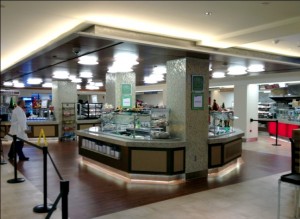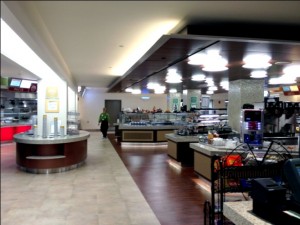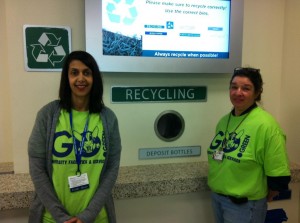University of Rochester
Sustainability @ the
University of Rochester
Strong Memorial Hospital: Café Renovation
January 2012
 Photo provided by SWBR Architects
Photo provided by SWBR ArchitectsThose who frequent Strong Memorial Hospital have probably seen the new, fabulous remodeled ‘Café 601’, completed in late 2012. The new facilities include new cooking equipment, food stations, salad bar, beverage dispensers, and a recycling center. In addition there are many more efficient and sustainable design aspects incorporated into the new cafeteria.
SWBR Architects collaborated with the University of Rochester Campus Planning, Design and Construction Management group, Medical Center Space Planning, DiMarco Constructors, LLC, IBC Engineering, and the Medical Center’s Food & Nutrition Services to create a design for the new cafeteria which included some remarkable sustainable features. Including Café 601, SWBR Architects have worked on over 300 projects for the University. According to SWBR’s mission statement, sustainability is “positive, long-term change. When considering any project we always look for opportunities to reduce energy demand, utilize healthy and environmentally sensitive materials, minimize waste, and provide a clean environment.”
In accordance with the University’s and SWBR’s shared mindset, LEED principles were applied where possible without compromising the budget. LEED is an internationally recognized ranking system, established by the U.S. Green Building Council, meant to give building owners a framework for green design, construction, and operation. It was a mentality that led to selection of certain materials, such as the flooring chosen for its low maintenance and minimal waxing needs. Virtually all of the lighting fixtures now contain light emitting diodes (LEDs) or compact fluorescent lamps (CFLs). LEDs are particularly bright, energy efficient, low maintenance, and while they have a higher upfront cost, the return on investment is fairly short.
 Photo provided by SWBR Architects
Photo provided by SWBR ArchitectsOverall, 96% of the construction waste materials were recycled, diverting over 15 tons of reusable material from the landfill. Materials used and bought for the renovation were done so with sustainability in mind. For example, the kitchen’s countertops proved challenging as the material needed to resist acid and chipping, and be sterile enough for food. The design team found a material made of recycled glass that fit all criteria, was high performing, and had the desired look for the cafeteria decor. This was just one of the ways the project team found a low cost high performing sustainable design product.
For the café, the design as a whole was energy conscious and changes were only made if it was clear they would save energy. For example, the area’s air handler was reworked to include a variable frequency drive (VFD). This means that when the café shuts down for the night, usually 9pm-5am, the fans’ speed is considerably reduced. Another example is during the summer, the café does not need to be cooled at the same rate overnight as it did during the day at full occupancy. Therefore it is logical, and efficient, that the fans do not need to be running on full power all night. VFDs are also on reheat and hot water systems.
Previously, the exhaust fans connected to the kitchen hoods ran at a constant volume, even during unoccupied hours. These fans could only be turned off manually which was unsafe and wasted energy. Now they are designed to be temperature sensitive and turn off automatically when the kitchen’s grills are shut down. In addition, the new dishwasher uses heat recovery to reuse excess steam from exhaust to pre-heat washing water to 128˚ before entering the final heating.
 Fazeelah Chappelo (left) and Ann Marie Marasco (right) of Univeristy Mail Services acting as "Recycling Rangers"
Fazeelah Chappelo (left) and Ann Marie Marasco (right) of Univeristy Mail Services acting as "Recycling Rangers"
The design team worked with the University’s Recycling Office to create a new recycling center. The station is neatly organized and complete with an instructional LCD screen. There are clearly labeled disposal sections for trash and recyclables. For the first few weeks, students and staff acted as ‘Recycling Rangers’ to help customers sort their waste properly.
The café’s food purchasing continues to prioritize local companies. Three of the primary vendors for the cafeteria are local businesses. B. Giambrone & Co. provides fresh produce from New York State in the summer and fall. SYSCO is based out of Syracuse and provides food year round. Palmer Food Service does the same. While local food is difficult to obtain in the winter, all of the café’s dairy products are from NY State. For the new cafeteria, Styrofoam containers have been phased out and replaced with compostable and recyclable containers. Did you know that the fiber take-out trays can be recycled? Simply put them on the tray return belt, the same place you put reusable trays, and they will be recycled by Food & Nutrition Services staff. There is also a renewed focus on providing healthy food that tastes good. While focusing on the customer’s desires, healthier choices were added as well as a commitment to a fresh environment.
As described by Dave Beinetti, architect and president of SWBR, renovations are difficult due to existing operational systems that are hard to significantly change within the operating space. These renovation projects are important to the overall environmental impact of the University. Addressing older building designs and equipment are imperative to the overall sustainability of the University.
Going forward, the Café is looking to implement a composting program for food waste and other organic material. In the meantime, enjoy the new cafeteria!
By Alanna Scheinerman, Class of 2013